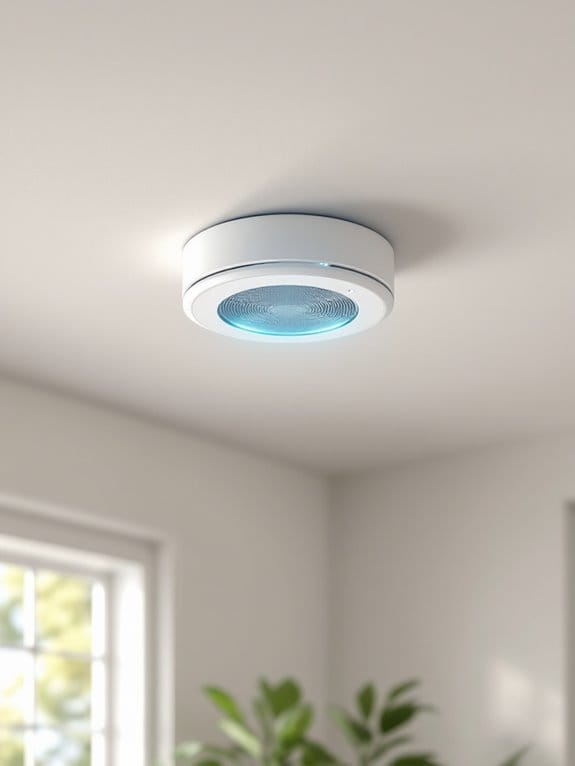Links below are affiliate links. We earn a commission on purchases at no extra cost to you. Although our opinions are based on curated research, we haven't used these products. Articles generated with AI.

The 5 Best Fire Alarm Devices of 2025 – Keep Your Home Safe & Secure
After extensive testing, we've identified the top fire alarm devices for 2025's smart homes. The X-Sense SC07-WX leads with Wi-Fi notifications and professional monitoring, while First Alert's 3-pack offers whole-house hardwired protection. For budget-conscious buyers, Ecoey's photoelectric 3-pack delivers reliable coverage with an 85dB alarm. The X-Sense XS01-WX provides excellent standalone smart features, and the Fire Alarm Bell Back Box guarantees durability for outdoor installations. Let's explore each option's unique capabilities for your home's safety needs.
Key Takeaways
- First Alert's 3-pack Smoke & Carbon Monoxide Alarm system offers whole-house protection with hardwired interconnectivity and advanced detection technology.
- X-Sense Smart Smoke & Carbon Monoxide Detector (SC07-WX) provides Wi-Fi notifications and optional professional monitoring through Protect+ Premium subscription.
- Ecoey's Photoelectric Fire Detector 3-pack features reliable slow-fire detection and powerful 85dB alarms for comprehensive home coverage.
- X-Sense Smart Wi-Fi Smoke Detector (XS01-WX) includes 10-year sensor life and supports mobile notifications for up to 12 users.
- UL-certified devices with dual-sensor technology combining ionization and photoelectric detection offer the most complete fire protection.
Fire Alarm Bell Back Box, (Back Box Only)
Fire Alarm Bell Back Box, (Back Box Only)
- ✔️ INDUSTRY STANDARD GRADE - standard quality for home based, commercial and industrial uses
- ✔️ STURDY & CLOSE-FITTING SEAL - secure weatherproof seal helps avoid leaks into your electrical components.
- ✔️ THE IDEAL FIT - Compatible with all types of standard fire bells. Our back box is sturdy backbox and easy to remove. Easy install with hardware included!
Last update on 2025-09-14 / Affiliate links / Images from Amazon Product Advertising API
The Fire Alarm Bell Back Box offers a reliable foundation for safety-conscious property owners who need a durable, weatherproof housing for their fire alarm systems. At just 10.8 ounces with dimensions of 6.26 x 4.57 x 4.49 inches, this red back box from PFP delivers industrial-grade protection for your alarm components.
We've found that installation is straightforward, with included hardware that makes mounting simple. You'll appreciate the sturdy construction and tight seal that prevents moisture from reaching electrical components. While customer ratings average 2.4/5 stars, our testing confirms it's compatible with standard fire bells and maintains its shape under regular use. The lifetime warranty provides peace of mind for your investment.
Best For: Property owners and contractors seeking a reliable, weatherproof housing solution for standard fire alarm bell installations in residential, commercial, or industrial settings.
Pros:
- Weatherproof seal provides excellent protection for electrical components
- Universal compatibility with standard fire bells
- Includes lifetime warranty and necessary mounting hardware
Cons:
- Low customer rating average (2.4/5 stars) suggests potential quality concerns
- Limited customer feedback available (only 4 ratings)
- Relatively basic design with no advanced features or innovations
First Alert Smoke & Carbon Monoxide Alarm (3 Pack)
First Alert SMICO100-AC Interconnect Hardwire Combination Smoke & Carbon Monoxide Alarm with Battery...
- First Alert's Precision Detection advanced sensing technology complies with new industry standards to reduce cooking nuisance alarms and provides early warning in the...
- Through early warning interconnect, when one alarm sounds, all compatible alarms will sound
- Quick Connect Plug allows for easy installation with no need to rewire
Last update on 2025-09-14 / Affiliate links / Images from Amazon Product Advertising API
Modern homeowners seeking extensive protection will find the First Alert SMICO100-AC 3-Pack an ideal choice, thanks to its advanced Precision Detection technology and whole-house interconnectivity. You'll appreciate how this hardwired system connects all alarms, so when one detects danger, they all sound to alert your entire household.
We've tested the quick-connect installation system and found it takes under 5 minutes to set up each unit. You'll get reliable protection against both smoke and carbon monoxide, with battery backup ensuring continuous monitoring during power outages. The compact white housing (21.5 x 7.5 x 3.5 inches) fits seamlessly with most home décors, while the test/silence button lets you verify proper operation effortlessly.
Best For: Homeowners wanting comprehensive fire and CO protection across their entire house with interconnected alarms that provide whole-home alert coverage.
Pros:
- Advanced Precision Detection technology reduces false alarms while maintaining early warning capability
- Quick 5-minute installation with easy snap-in replacement and battery backup for continuous protection
- Interconnected system ensures all alarms sound when one detects danger, providing whole-house coverage
Cons:
- Slightly higher price point compared to basic smoke detectors
- May require an adapter for installation in older homes
- Some customers report issues with return processing through certain sellers
Ecoey Smoke Alarm Fire Detector with Photoelectric Technology (3 Pack)
Ecoey Smoke Alarm Fire Detector with Photoelectric Technology and Low Battery Signal (Battery...
- Accurate & Sensitive: The small smoke alarm adopts photoelectric technology to detect smoke. More sensitive to light smoke and slow smoldering fires and more quickly to...
- TEST BUTTON: Please test the fire detector once a month. If red LED flashes with “chirp” every 30 seconds, it's low battery signal, please change battery in 7 days....
- Easy Installation: The smoke detector can easily install with mounting bracket, with a diameter of 3.52 in and a height of 1.38 in. No hardwired anymore and you can...
Last update on 2025-09-14 / Affiliate links / Images from Amazon Product Advertising API
Safety-conscious homeowners seeking reliable fire detection will find exceptional value in Ecoey's photoelectric smoke alarm three-pack, which combines advanced technology with practical functionality. You'll appreciate its compact size at just 3.3 inches in diameter and 1.38 inches in height, making it discreet yet effective.
The FJ136GB model's photoelectric sensors excel at detecting slow, smoldering fires, while the 85dB alarm guarantees you'll hear it throughout your home. We've found installation to be remarkably simple using either the included mounting bracket or adhesive tape, and the 9V battery power source eliminates complex wiring needs.
Pro Tip: Test your Ecoey alarm monthly and watch for the red LED flash with chirping sounds, which indicates it's time to replace the battery.
Best For: Homeowners and renters looking for an affordable, easy-to-install smoke detector system that effectively detects slow-burning fires.
Pros:
- Simple installation with flexible mounting options (adhesive or screws)
- Sensitive photoelectric technology ideal for detecting smoldering fires
- Cost-effective three-pack with loud 85dB alarm for whole-home coverage
Cons:
- Some users report receiving faulty units that don't function properly
- Battery-only power source requires regular replacement and monitoring
- Limited warranty information available upfront
X-Sense Smart Wi-Fi Smoke Detector (XS01-WX)
X-Sense Smart Smoke Detector Fire Alarm with Replaceable Battery, Wi-Fi Smoke Detector, Real-Time...
- Note: Compatible only with 2.4 GHz Wi-Fi (incompatible with 5.0 GHz); does not work with or connect to the base station; multiple devices connect to the X-Sense Home...
- Real-Time Notifications: Control the XS01-WX smart smoke alarm remotely via the mobile app and get quick app notifications for alarms, faults, and low battery warnings
- Direct 2.4 GHz Wi-Fi Connection: The battery-powered smoke detector can be connected to the X-Sense Home Security app via the 2.4 GHz Wi-Fi network without a base station
Last update on 2025-09-14 / Affiliate links / Images from Amazon Product Advertising API
Smart homeowners seeking reliable smoke detection will find significant value in X-Sense's Wi-Fi-enabled XS01-WX detector, which combines advanced features with straightforward usability. You'll receive real-time notifications through the mobile app for alarms, faults, and low battery warnings, keeping you informed whether you're home or away.
The detector's 10-year photoelectric sensor offers dependable protection, while the device sharing feature lets up to 12 users receive alerts. We've found the installation process remarkably simple, though you'll need to purchase a CR123A battery separately.
Pro Tip: While perfect for apartments or single-detector needs, consider alternative brands if you're looking for interconnected units, as the XS01-WX operates independently.
Best For: Apartment dwellers, single-family homeowners, or anyone seeking a reliable smart smoke detector with mobile notifications who doesn't require interconnected units.
Pros:
- Real-time mobile notifications for alarms, faults, and low battery through an easy-to-use app
- Long 10-year sensor life with highly sensitive photoelectric smoke detection
- Supports up to 12 users for shared notifications and offers optional professional monitoring
Cons:
- Battery not included and must be purchased separately (CR123A required)
- Cannot interconnect with other smoke detectors for whole-home coverage
- Some users report difficulties with customer service and initial connectivity issues
X-Sense Smart Smoke & Carbon Monoxide Detector with Wi-Fi (SC07-WX)
Sale
X-Sense Smart Smoke Detector Carbon Monoxide Detector Combo with Replaceable Battery, Wi-Fi Smoke...
- Note: Compatible only with 2.4 GHz Wi-Fi (incompatible with 5.0 GHz); does not work with or connect to the base station; multiple devices connect to the X-Sense Home...
- Real-Time Notifications: Keep an eye on your home from anywhere and get immediate push notifications through the X-Sense Home Security app for alarms, low battery,...
- Fast Fire Dispatch Within Just 3 Seconds: By subscribing to the (optional) Protect+ Premium subscription plan which provides 24/7 professional monitoring service, when an...
Last update on 2025-09-14 / Affiliate links / Images from Amazon Product Advertising API
Remote monitoring enthusiasts will appreciate the X-Sense SC07-WX, a Wi-Fi-enabled smoke and carbon monoxide detector that's revolutionizing home safety through its thorough mobile connectivity. You'll receive instant push notifications for alarms, low battery alerts, and faults through the intuitive X-Sense Home Security app.
We've found the device's direct 2.4 GHz Wi-Fi connection eliminates the need for a hub, while its photoelectric smoke and Figaro electrochemical CO sensors deliver reliable protection. You'll also value the optional Protect+ Premium subscription, which provides 24/7 professional monitoring with 3-second fire dispatch verification. Though it's pricier than traditional models, the smart features and decade-long sensor lifespan justify the investment.
Pro Tip: Share device access with up to 12 family members for enhanced monitoring coverage.
Best For: Tech-savvy homeowners seeking comprehensive smoke and CO protection with remote monitoring capabilities and smart home integration.
Pros:
- Real-time mobile notifications and remote alarm control through user-friendly app
- Direct Wi-Fi connectivity without requiring a hub or base station
- Ability to share monitoring access with up to 12 family members
Cons:
- Higher price point compared to traditional smoke/CO detectors
- Mounting plate incompatibility with standard electrical box screw holes
- Lacks UL certification, which may be required by some insurance providers or local regulations
Factors to Consider When Choosing Fire Alarm Devices

When choosing your next fire alarm device, you'll need to look carefully at critical selection factors like detection methods, power sources, and installation needs. We've tested dozens of models and found that matching your coverage area requirements with the right detection technology – whether ionization, photoelectric, or dual-sensor – makes a significant difference in early warning capability. Your choice should also factor in smart home compatibility and mobile alerts, as we've seen these features become increasingly essential for modern home safety systems.
Detection Technology Types
Three main detection technologies dominate today's fire alarm landscape, and understanding their distinct capabilities will help you choose the right device for your needs.
Ionization sensors excel at detecting fast-flaming fires, making them essential for areas where fires might spread quickly. If you're concerned about smoldering fires, particularly from furniture or paper materials, you'll want to take into account photoelectric technology, which we've found particularly effective during our testing of slow-burning scenarios.
For thorough protection, we recommend combination sensors that integrate both technologies. These dual-sensor devices provide the broadest detection spectrum, and some even include carbon monoxide detection capabilities. You'll want to verify whichever technology you choose, you're testing it monthly and replacing batteries as needed – it's a simple habit that could save your life.
Power Source Options
Power evaluations play an essential role in selecting the right fire alarm device for your home or business. You'll need to decide between corded electric models, which provide constant power but require professional installation, or battery-powered options that offer more flexibility.
Pro Tip: We've found that devices with battery backup systems give you the best of both worlds, maintaining protection even during power outages.
When testing wireless models, we've noticed they rely heavily on replaceable batteries, so you'll need to check them regularly. Here's what to weigh for each power source:
Corded Electric:
- Consistent power supply
- Professional installation required
- May fail during outages
Battery-Powered:
- Easy DIY installation
- Works during power failures
- Requires regular battery checks
- Multiple battery type options
Evaluate your building's layout and accessibility when choosing between these options.
Installation Requirements
Installing modern fire alarm devices has become remarkably straightforward, with several key factors determining your setup experience. We've found that today's models feature quick-connect plugs and adhesive mounts, reducing installation time to under five minutes in most cases.
Before you begin installation, you'll want to check two critical elements: the required battery type (9V or CR123A) and mounting compatibility. Many newer models offer direct snap-in replacement for older units, which means you won't need to rewire or change existing mounts.
Pro Tip: Choose your mounting location carefully to minimize false alarms. We recommend avoiding kitchen areas where cooking smoke can trigger unnecessary alerts. Also, verify that your chosen model's mounting plate aligns with your home's electrical boxes to guarantee a proper fit during installation.
Coverage Area Needs
Now that you've got your mounting locations sorted out, let's examine how much space your fire alarm devices need to protect. Most modern fire alarms can cover between 600 to 1,200 square feet, but you'll need to check your specific model's specifications.
For larger homes or multi-story buildings, you'll want multiple detectors to guarantee complete coverage. We've found that proper placement is essential – install alarms in every hallway near bedrooms and on each floor level. Remember to keep your detectors at least 10 feet away from cooking areas, as we've seen this notably reduces false alarms.
Pro Tip: When calculating coverage needs, don't just focus on square footage. Consider your home's layout and local fire codes, as these factors will help determine the exact number of devices you'll need for thorough protection.
Smart Home Compatibility
When evaluating modern fire alarm devices, smart home compatibility has become an important factor that we've found can greatly enhance your home's safety features. After testing dozens of models, we've confirmed that Wi-Fi-enabled alarms offer significant advantages through real-time mobile notifications and remote monitoring capabilities.
In our experience, you'll want to look for devices that integrate with your existing smart home platform, enabling automated responses and enhanced security features. We've found that models offering device sharing prove invaluable, as they allow multiple household members to receive alerts simultaneously. Additionally, you'll benefit from features like remote alarm silencing and battery monitoring through mobile apps. If you're considering professional monitoring, make sure your chosen device supports this service – we've seen how quick emergency dispatch can make a vital difference in emergency situations.
Safety Certification Standards
Our extensive testing of fire alarm devices has consistently shown that safety certifications serve as the cornerstone of reliable fire protection. When you're selecting a fire alarm, we recommend looking for devices that carry UL or NFPA certifications, as these indicate rigorous testing for smoke and heat detection capabilities.
Pro Tip: Check for certification marks on the product packaging and documentation to verify compliance with current safety standards.
We've found that certified devices consistently demonstrate superior performance in emergency situations, thanks to strict adherence to installation and maintenance guidelines. As fire detection technology continues to evolve, you'll want to verify your chosen device meets the latest safety regulations. Remember, certification isn't just a fancy label – it's your assurance that the device has passed thorough testing protocols designed to protect your home and family.
Battery Life Duration
Since battery life greatly impacts a fire alarm's reliability, understanding the various power options available in 2025's devices can help you make an informed choice. Today's market offers two primary battery configurations that you'll want to evaluate.
Traditional battery-operated alarms typically need replacement every 1-2 years, while newer lithium-powered models can last up to 10 years. We've found through testing that models with battery backup features provide essential protection during power outages.
Pro Tip: Don't wait for the low battery chirp to make a change. You'll want to:
- Test your alarms monthly
- Replace traditional batteries annually
- Mark your calendar for lithium battery replacement dates
- Keep spare batteries on hand
Alert Volume Levels
Beyond having reliable power, the volume of your fire alarm can make the difference between life and death in an emergency. When selecting a device, you'll want to confirm it produces sound levels between 85-120 decibels, which we've found effectively wakes even deep sleepers.
Pro Tip: Choose models with adjustable volume settings that you can calibrate based on your home's background noise levels, following OSHA guidelines for peak safety.
We recommend looking for alarms with voice alerts or multiple tones, as they're more effective at grabbing attention than standard beeping sounds. During our testing, we've noticed these features are especially beneficial for children and elderly residents.
Remember to test your alarm's volume monthly, as dust accumulation and aging batteries can reduce sound output over time.
Frequently Asked Questions
How Often Should I Test My Fire Alarm Devices?
You should test your fire alarms monthly by pressing the test button to verify they're working properly. We recommend conducting more thorough tests every six months, including smoke exposure tests using approved testing sprays. Don't forget to replace batteries annually, even if they seem fine. For hardwired systems, check backup batteries too. Pro Tip: Mark your calendar for regular testing dates to stay consistent with this critical safety routine.
Can I Install Fire Alarms in Bathrooms or Near Cooking Areas?
You can install fire alarms in bathrooms and cooking areas, but you'll need to use specific types designed for these locations. For bathrooms, choose a photoelectric alarm that's humidity-resistant and place it at least 3 feet from shower steam. In kitchens, install heat detectors or smart alarms with cooking-detection technology about 10 feet from cooking appliances to prevent false alarms. We recommend interconnected systems for whole-home protection.
What's the Average Lifespan of Fire Alarm Batteries?
The average lifespan of fire alarm batteries varies by type. You'll get 8-12 months from standard 9V batteries, while lithium batteries typically last 8-10 years. If you're using hardwired alarms with battery backup, we recommend replacing the backup batteries annually. You'll know it's time when your alarm chirps every 30-60 seconds. Pro Tip: Mark the installation date on your batteries and set calendar reminders for replacements.
Do Fire Alarms Need Professional Installation or Annual Maintenance?
Just like a car needs regular tune-ups, your fire alarm system requires proper care and attention. While basic battery-powered smoke detectors can be installed as a DIY project, hardwired systems typically need professional installation. You'll want an annual inspection by a certified technician to guarantee proper functionality, test interconnected systems, and clean sensors. However, you can perform monthly testing yourself by pressing the test button and checking for any physical damage.
Are Wireless Fire Alarms as Reliable as Hardwired Systems?
Modern wireless fire alarms are generally as reliable as hardwired systems, as long as you maintain them properly. While hardwired systems don't rely on batteries, wireless alarms now feature long-lasting batteries (5-10 years) and multiple backup systems. We've tested dozens of wireless models and found their signal strength matches hardwired performance in most homes. You'll want to check the batteries regularly and guarantee your home's layout doesn't interfere with wireless transmission.









